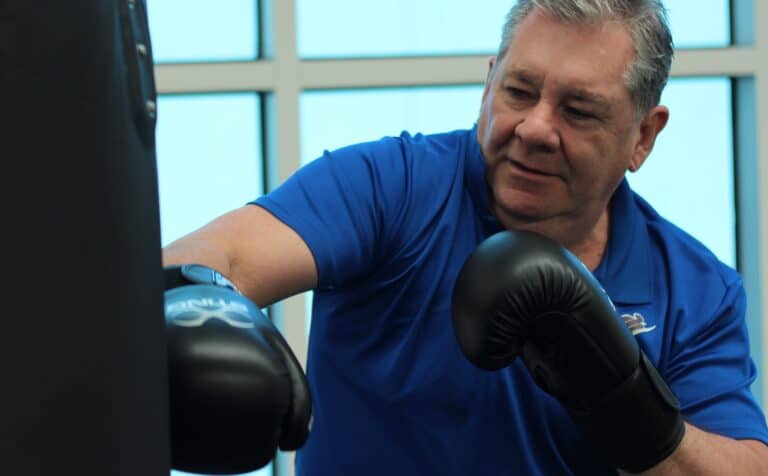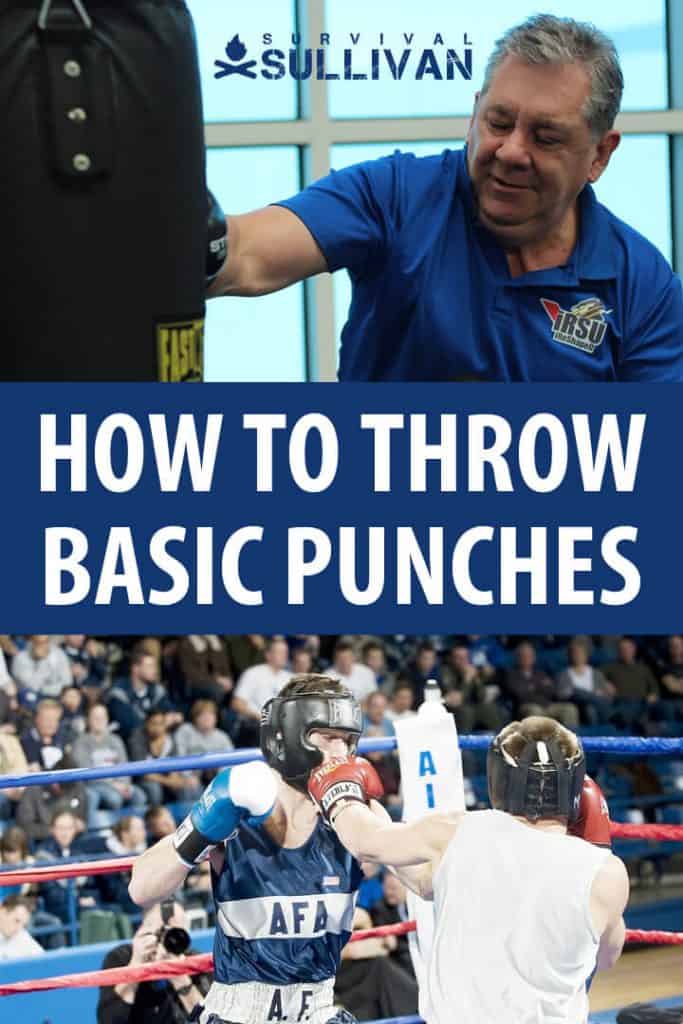Real self-defense is often a crapshoot. Even with excellent awareness, refined skills and sharpened reflexes, the bad guy will always get to choose the time, location and duration of the attack.

Just because you are armed, ready and willing does not mean you’ll always get to employ weapons and gadgets to aid in your defense. Sometimes there is just no time to react; you were caught flat-footed or distracted.
In times like this, you’ll have to rely on the most fundamental of weapons: your fists and feet. Of the two your hands are the most instinctively brought to bear and the quickest into action.
A good punch, delivered properly, can pack a surprising amount of force and inflict considerable damage, staggering or stopping an attack outright and buying time for you to go on the offensive or bring weapons to bear if needed. Sometimes an attack will warrant defensive force, but not lethal force, and so punching is your best option.
In my third boxing article, we’ll be learning how to throw a variety of basic punches to help you survive encounters on the street and elsewhere. So break out those hand wraps and let’s get started.
Table of Contents
A Man’s Got to Know His Limitations
Before we get to the fun part- making you a one man wrecking crew (right)- I must preface the information I am going to present lest I be accused of hawking Charles Atlas-style programming: you will not learn to fight on the internet. I know, I know: hard to believe but it is true.
You can get a leg up on your training and eve find ways to refine your existing skills and practice sessions but if you are not willing to get training from an expert you will not prosper.
Sure, anyone can ball up their hand and slam it into another person, but that is not likely to be as effective in a fight unless you are lucky or a major brute.
Compared to good boxing form, you’ll run a higher chance of hurting your hand, wrist or arm and you won’t inflict as much damage while simultaneously leaving yourself more vulnerable to retaliation. Plus you won’t look as cool, and looking cool is the best defense. Okay, I’m kidding about the last part.
If you are brand new to boxing, or have just never been in a fight, use this article as a sort of primer to ease yourself into a real education in pugilism. And, yes, that includes getting hit. A bunch. Accept it now. Vasyl Lomachenko you aren’t, friend.
The Clash of Bone and Sinew
Punching is a fast, effective and inseparable means of defense. A solid punch can break bones, knock a foe out or just dump them on their ass, leaving you free to skedaddle or follow-up with more devastating attacks to shut them down for a time. But this “crudest” of weapon systems is not without its drawbacks.
Your typical high-value target on a human, the head, is a hard target. One of the hardest, in fact; the frontal facings of the skull are very dense and hard, and if you want to slam your fist into it at high speed you might pay the piper.
Broken fingers, wrist bones and bones in the forearm are very common when punching for keeps. Dislocated knuckles and severe jams of the fingers are not uncommon. Any of these injuries will definitely hurt, and may become debilitating immediately or in the aftermath of a fight.
This is something to think about in light of a long term SHTF situation since you’ll need your hands for all kinds of delicate work like running guns, using lights, building, fixing and rendering aid. This is the chief reason while training in boxing (or at least throwing punches correctly) is so important.
Good form, conditioning of the bones in the hands and proper technique equates to better power delivery and reduced chances of injury.
Even with these risks, your fists are too good and convenient a weapon to risk not using them when the time is right.
Stance and Fundamentals
Boxing is often referred to as the “sweet science” since it is comprised of several fundamentally simple maneuvers and concepts that are combined in nearly infinite ways with nearly boundless opportunity for refinement.
Therein lies the magic: while you can learn the fundamentals of basic punches in a couple of days, you’ll spend a lifetime working on them to attain mastery in the form of better speed, precision and so forth.
That being said, if you do nothing else but learn how to defend reasonably well, move reasonably well and throw a few half-decent punches you’ll be able to starch half-assed attackers into rethinking their life choices, or shutting down a someone who’s been drinking or crazy person. To accomplish all that you’ll need to, literally, build a good foundation.
You cannot throw a good technical punch without adopting a proper stance. Sure, some looping, wacky bear slap or haymaker might pack a lot of power but they are not consistent or reliable.
A good boxing stance will let you chamber and fire punches quickly and effectively. To assume the basic stance, you’ll start by setting your feet. It all starts with the feet!
Setting the Stance
This comes down to a individual preference, depending if you want crushing knockout power at the cost of mobility or mobility at the cost of power, but you generally want your feet a little wider than shoulder-width apart.
The closer your feet are to your centerline the more power you will be able to generate while a wider stance affords better balance and maneuverability.
Once you have set your feet, time to reposition them: your “strong” or dominant side leg should trail your non-dominant leg. Position your strong leg to the rear a little. Both feet should be pointing in the same direction.
This should result in a bladed stance that will minimize your frontal area to an attacker and keep you from being a “broadside” target: if an attacker can hit you squarely, you’ll be in for more pain and damage.
Just like a bullet. This bladed position also keeps your power arm to the rear, able to generate more speed and power on the way to your attacker’s squishy, squishy nose.
Once you have the geometry of the stance set, it is time to refine it. First, relax. Staying tense and rigid will slow you down and burn energy. Relax. Be loose. A little bouncy on your feet.
Weight distribution should be evenly distributed across the balls of both feet, not the heels. You must be capable of rapid forward, backward and lateral movement both for landing powerful punches but also for evasion.
Okay, looking good. Now the last things you do is tuck your chin to protect your jaw and throat, keep your fists up around eye level and pull your elbows in tight to the body. These are all essential tips for defense.
A good punch to the chin will knock you out in a New York minute and the vulnerability of the throat to a punch or other blow was covered extensively already I my first article.
Your elbows should be pulled in tight to your ribs to afford your torso some protection and also to increase the speed you can fire off punches.
Not bad, not bad at all. I would not throw you in the ring with Mayweather or Tyson, but you’ll be ready to dot some eyes in no time. It is from this position that you’ll do so, and all of your punches will be delivered from here.
The Basic Punches
Your basic punches in boxing are the jab, the cross (or straight), the hook and the uppercut. Used together, the applications and utility are almost endless, but that is what separates the pros from the amateurs.
Even so, a handful of good punches and some basic combinations will go a long way to shoring up your hand to hand capability. Most people, even tough, ornery naturally, ah, “asocial” types are not good fighters and will leave plenty of openings for stiff shots with no opener needed.
That’s enough preamble, ring the bell and let’s get to the punches!
The Jab
The jab is the foundational punch, defensively and offensively. The jab is used all the time and for moment-to-moment reasons in a fight. A jab is not a “power” punch through a particularly accurate and peppery jab may stun or knock someone out. A jab can be fired quickly and rapidly is used to hurt an opponent, to distract him and to setup bigger, meaner blows.
A jab is also your ranging tool, and will inform you if you are in the “sweet spot” distance band from your foe so you can land a whopper on him. A crisp jab can disrupt an opponent’s advance or make him hesitate before committing; both are opportunities you can use.
A jab is thrown with your non-dominant hand. Like all punches, a good jab is not just arm movement. When punching, it is the transfer of weight and the resulting momentum that creates real power.
A jab is begun by transferring your weight to your front foot. At the same time, the non-dominant arm is snapped forward while the hand is rotated inward toward the centerline of the body. Do not neglect that part: this rotation is another power-generating element.
Just prior to full extension the jab should be connecting and at full extension the fist should be rotated just past the horizon by about 25 to 30 degrees. After you connect, get that thing back and follow up with another punch, even if it is just another jab. Never throw a lone jab unless it is to provoke a response!
The Cross/Straight
The cross, or straight punch, is your utility power punch, easily capable of knocking someone out with a good hit or inflicting serious damage.
The cross often follows a jab or series of jabs and is an element in almost every combination. A cross relies heavily on the power generated by rotation of the torso and is ready to launch as soon as you start to retract the jab.
Notice how the right hand and shoulder are farther back when the jab is at full extension? Bingo; as soon as the jab connects and you start to retract it transfer your weight forward and heavily onto your leading foot and fully open (or rotate forward) your dominate shoulder as you fire the cross straight and directly toward your target. You should rotate the hand and wrist inward as you do with the jab.
The movement is more exaggerated all around but the cross, mechanically, is very similar to a jab, originating from the opposite hand and you can easily see the synergy with which they work together.
Even so, while you can retract a straight back to guard quickly, it takes longer and is a bigger commitment (and risk) than popping off a jab, which is why you typically will not lead with one unless the opportunity is high-percentage.
The Hook
The hook is another power punch in your arsenal and all the more dangerous compared to the cross for another, different reason: the hook can be very hard to see coming when you are busy defending or reeling from other punches.
The hook can originate from either hand but is more technically challenging to execute properly. The hook is unique in that the beginning of the punch starts with a major movement of the same-side leg.
The hook-side leg is rotated inward (the same direction the punch is heading) immediately before the torso is twisted in the same direction. The torso in turn is moved immediately before the arm and fist follow the movement.
The arm is held in such a way that the elbow remains in-line and behind the fist to provide a rigid structure for the strike. The arm is not so much thrown at the target as it is held firm allowing the rotational energy of the leg, hips and trunk to carry it into and through the target, resulting in quite a bell-ringer of a hit.
You always want to aim “behind” your target for the purposes of follow-through in order to ensure maximum power delivery with any punch, but this principle is vital for a good hook. If in doubt, put some Irish on it and deliver it with hate in your heart. Try to knock their block off.
Because the hook is a little slower and more technically challenging to deploy than the jab or straight, most pugilists will advise you not to lead with it. It is easy to see coming on its own and there is a greater propensity to expose the chin and neck when throwing one (keep your chin DOWN!).
For these reasons, a hook is usually integrated into a combination or thrown at the end of a sequence on the side opposite where your opponent has biased their guard.
The unusual attack angle means this can be a major surprise and a knockout hit. As I mentioned in my previous articles, the punch you don’t see is the one that most often puts you to sleep.
The Uppercut
The uppercut is a cousin of sorts to the hook as they are both mechanically similar and should be deployed similarly. Do not lead with an uppercut; instead look for opportunities to work it into a combination or at the end of a sequence unless the opportunity to use it for devastating effect is great.
An uppercut is a vicious knockout strike when the opponent is doubled over or dropping their head, and also has good utility as a rib-cracking body blow.
If you imagine yourself throwing a hook, only with your body tilted about 30 degrees to one side, that is what an uppercut looks like. To throw the uppercut, the hips on the same side are rotated in the same direction as the punch. Then tilt your upper torso and shoulders to the side while simultaneously twisting in the same direction as your hips.
From here, the arm is held in the same fashion as a hook; elbow rigidly in line with the fist, arm kept firm. Power is generated by the rotation of the hips and the torso, not the arm itself. The uppercut travels upward diagonally across the body (again, think a cross tilted on its side a bit) not truly vertical.
Putting it All Together
Another old boxer’s maxim is “punches in bunches.” A lone punch leaves too much room for interception or a counter attack. Chances are you won’t knock someone out in a single blow. If your middle of the mall-grade punk is not sent fleeing by a bloodied or broken nose, you should count on having to beat them in to submission at any rate. Anyone worth punching is worth punching thrice!
Some folks won’t start to get the message until they have taken several good lumps while doling out little in return. Others just won’t quit until they have been pummeled into near unconsciousness. Whatever the case, never throw one punch. Two at the minimum, three is better.
If you see that your blows are “telling” or having good effect (wobbling, hands dropping, loss of coordination) you have a choice to make: close the deal and really pour it on or use the window of opportunity to escape or activate another defensive option.
Conclusion
Punching is a timeless way to inflict pain and suffering on someone and is one of the only defensive options that we will truly always have available. Like any defensive option, make the most of it by learning to maximize its effect and your effectiveness with them.
Even if you do not take up boxing as a serious discipline or hobby, learning to properly deliver a variety of punches on demand will greatly increase your effectiveness when it is time to put up your dukes.


Charles Yor is an advocate of low-profile preparation, readiness as a virtue and avoiding trouble before it starts. He has enjoyed a long career in personal security implementation throughout the lower 48 of the United States.
